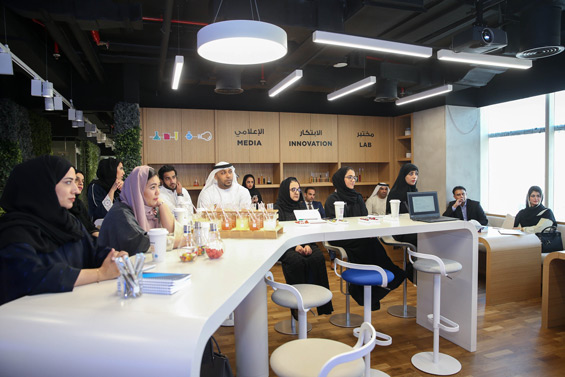- City Fajr Shuruq Duhr Asr Magrib Isha
- Dubai 04:20 05:42 12:28 15:53 19:08 20:30

Michael Wu, Chief Scientist of Lithium Technologies, on Social Media Return on Investment (ROI), explained how one can gain a deeper understanding of the process of influence by using a simplified model of social media influence.(Supplied)
The Government of Dubai Media Office (GDMO) on Monday hosted the second workshop in its Media Innovation Lab series.
Michael Wu, Chief Scientist of Lithium Technologies, on Social Media Return on Investment (ROI), in his presentation, underlined the importance of an influencer strategy in promoting brands and products. Wu explained how one can gain a deeper understanding of the process of influence by using a simplified model of social media influence.
GDMO’s Media Innovation Lab is a unique series of events focused on sharing knowledge on media innovations that have a far-reaching impact on the industry and beyond. Featuring events every quarter, the initiative has the aim of inculcating a culture of innovation and creativity within the media industry.
Speaking about how influencers can be found and engaged with, Wu said the influencer's power to influence depends on six factors – credibility, bandwidth, relevance, timing, alignment and confidence. Credibility essentially is about the influencer's expertise in a specific domain of knowledge while bandwidth is about the influencer's ability to transmit his expert knowledge through a social media channel.
The target audience's likelihood of being influenced by the influencer is determined by relevance - how closely the target audience's information needs to coincide with the influencer's expertise.

The fourth factor is timing. The ability of the influencer to deliver his expert knowledge to the target at the time when the target needs it is also critical for influence to take place since there is only a small time-window in the decision-making process for the target to be influenced.
The other critical factor that affects the target’s likelihood to be influenced is alignment or the amount of channel overlap between the target and the influencer. If the target is on a different social media channel, then the influencer's information either takes too long or never reaches the target. The sixth key factor is confidence, or in other words, how much the target trusts the influencer with respect to his or her information needs. Even if the influencer is credible, the target must have confidence in him. Without trust, any information from the influencer will be downgraded by the target.
In engaging with influencers, organisations should not treat influencers as employees, said Wu. Nor should they be paid or blatantly promoted. All these could lead to the influencer losing credibility. On the other hand, if they are left alone, word of mouth from them will not propagate far due to the decay effect of time and distance. Uncoordinated word of mouth, he said, has low efficacy. However, community can overcome the decay effect of distance and time on word of mouth.
Wu suggests that organisations should co-create value with influencers by using a community. The community provides an audience for the influencer and amplifies their influence, said Wu. The brand sponsoring the community gets the benefit of effective word of mouth through the influencer, creating a win-win-win situation for everyone.
Wu’s next Media Innovation Lab workshop on November 25 will be on how ‘gamification’ techniques can be used to solve big business problems that involve long-term behaviour change.
Apart from Wu, the initial series of Media Innovation Lab events feature workshops by Joyce Baz, Regional Communications Manager for Google in the Middle East; and video production expert Joel Schaeffer.
![]() Follow Emirates 24|7 on Google News.
Follow Emirates 24|7 on Google News.